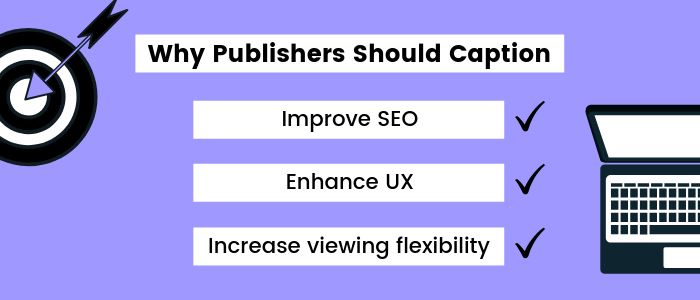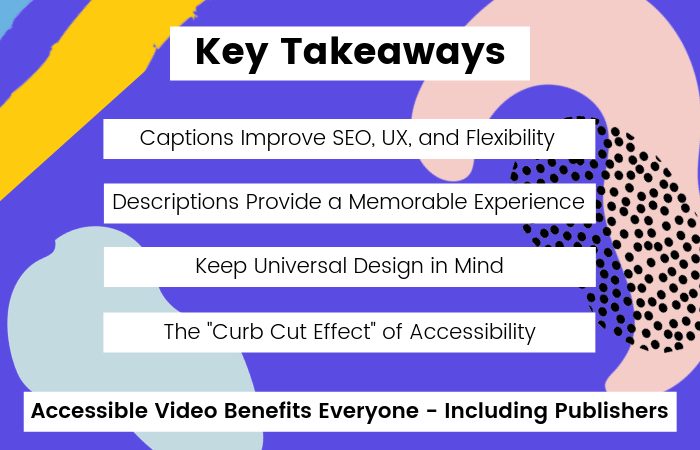The Benefits of Accessible Video for Publishers
Updated: August 23, 2024
The power of accessible video is far-reaching, and there are many ways in which captions and audio description can benefit video publishers. Captions can boost SEO and improve the learning experience for students, and audio description lends itself to universal design and makes content viewing more flexible for various environments such as driving.
In addition to the many benefits captions and audio description provide to viewers, these accessibility tools can also benefit video publishers.
Let’s talk a bit more about the great things accessible video can do for publishers, and why all publishers should consider making captioning and audio describing a priority.
Why Publishers Should Caption
Closed captions, or captions, are a visual representation of the audio in a video. Besides displaying the spoken dialogue, captions also depict non-speech elements like speaker IDs and sound effects like a car horn or a ringtone.
Let’s talk about why video publishers should fall in love with captions.

SEO
Most of us want people to know who we are and to be able to find us easily – that’s where search engine optimization (SEO) comes in.
Search engine optimization, a likely familiar term, is a process that aims to increase the visibility of websites and pages. That’s all well and good, but, have you ever heard of video SEO? Just like written content, videos can be ranked on search engines. Though this concept may seem foreign for some compared to traditional SEO, it’s actually similar in principle. When done right, optimizing video for SEO helps both views and website traffic to skyrocket.
One way to get search engine bots crawling towards your video content is – you guessed it – captioning. Associating a text caption file with a video is enough to grab the attention of search engines, which can’t technically view video content the way we can. This will improve the chance that your videos will rise in ranks and be seen by more people.
User Experience
We all want our content to be the best of the best, and to be memorable. Well, captions can do just that for your video content. A research study from the Journal of the Academy of Marketing Science found that captions improve brand recall, verbal memory, and behavioral intent.
With captions, your video content will be more engaging and will encourage people to keep coming back for more of what you have to offer. Our job as creators is to delight our audience, and with accurate captions, you can do just that.
Viewing Flexibility
Allowing viewers to watch videos in multiple environments could be key to getting your message in front of more eyes. That flexibility is made possible by adding captions to videos.
Take this example for instance: In 2016, Facebook found that 80% of viewers react negatively to videos that autoplay with the sound on. This reigns true especially for those in sound-sensitive environments like public transportation, gyms, and libraries. However, if a video plays on silent and is without closed captions, a viewer will likely keep on scrolling since they have no context and no desire to click into the video for sound. That’s why captioning videos is so crucial for publishers today – it could be the factor that gets people to watch your videos, especially on social media.
Get creative with your captions and make them look visually appealing. This can encourage viewers to keep their eyes on your videos and to watch them from start to finish.
Why Publishers Should Describe
Audio description is an audio track that narrates the relevant visual information in media and was developed to aid people who are blind or have low vision. We refer to the process of audio description as describing since it describes the key visual elements that are necessary to understand the content.
So, how can audio description benefit video publishers?

Create a New Experience
Who doesn’t want to be forward thinking, innovative, and ahead of the curve? Keeping your audience wanting more is all about creating new experiences that they can remember, and audio description gives the audience a new, exciting way to interact with your content.
People are getting creative with audio description and the way they interact with videos. In the past, the concept of driving while also watching your favorite TV shows seemed incredibly dangerous, and rightfully so. However, audio description allows drivers to listen to movies and TV shows, almost like they would an audiobook. This is entirely possible for any type of video, especially if the descriptions are high quality and well done.
We’ve no doubt that, given the opportunity, your viewers will love the elevated and unique viewing experience that audio description provides.
Universal Design and Flexibility
Universal design means designing in a way that gives people multiple ways of interacting with various types of content. For example, people utilize captions to interact with a video more visually, and they use audio description to interact with videos in a more auditory way. It’s all about anticipating the different needs of various individuals and situations and then designing to serve those needs.
Take students for instance: 20-30% of students say that they retain information best through sound. Their learning experience would certainly be enhanced with audio description.
Audio description also combats perceptual blindness, which is what happens when an individual fails to perceive something in plain sight due to lack of attention. Similarly, people often watch videos and then get distracted by something such as a household conversation or a task. However, when audio description is on, it points out all of the key visual elements that the distracted person may have otherwise missed.
By practicing universal design and supplementing videos with descriptions, your video content will be more flexible and engaging for viewers.
Accessibility and the Curb Cut Effect
Amidst all the benefits of captioning and audio description for publishers, accessibility is at the top for several reasons. Most importantly, videos need captions to be accessible for people who are deaf or hard of hearing and audio description for people who are blind or low vision. Captions and descriptions aid people with other disabilities, too, such as learning disabilities, neurological disorders, or autism.
Don’t forget that laws such as the Rehabilitation Act and the Americans with Disabilities Act (ADA) require many organizations to caption their videos. But, even if these laws do not apply to you, dear publisher, it’s still absolutely worth it to ensure your video content is accessible.
Accessibility doesn’t just apply to people with disabilities. Have you ever heard of the “curb cut effect?” The concept stems from the origins of sidewalk curb cuts, which were initially developed to make sidewalks accessible for people in wheelchairs. Today, anyone can benefit from curb cuts including parents with baby strollers, people using crutches temporarily, and even people rolling large garbage bins onto the street for trash pickup.
The point is, captions and audio descriptions have evolved beyond their original use-case and have become of great use for all kinds of people and situations. For example, watching videos in sound-sensitive environments is made possible with captions, and watching your favorite show while you clean the living room just became ten times easier with audio description.
So, there you have it! Accessible videos are great for publishers for many reasons, from making videos more engaging to boosting SEO to creating a new experience altogether. All of these things will help keep your audience coming back for more. From where we’re standing, it looks like making your videos accessible is the way to go.
Are you ready to reap the benefits of accessible video?






